
The Brij Disa Centre for Data Science and Artificial Intelligence (CDSA) at the Indian Institute of Management Ahmedabad (IIMA) provides a common platform to faculty, scholars, and practitioners for conducting and disseminating cutting-edge research on data analytics and artificial intelligence that offers solutions applicable to business, governance, and policy.
Besides generating action oriented insights, CDSA is also responsible for dissemination of the knowledge generated to a wider audience both within and outside the realm of the Institute. Seminars, workshops, and conferences are regular activities at the Centre, which are conducted to reach out to and engage with stakeholders.
The Centre aims to forge synergistic and collaborative relationships between scholars and practitioners in dataintensive organizations, besides undertaking case-based research to understand the current industry practice and develop case studies for classroom teaching.
Furthermore, through its collaboration with the industry, CDSA takes up challenging consulting projects of considerable practical importance. These projects are targeted at providing an opportunity for students to participate in projects that aim at outcomes that can further benefit the organisation and the business, at large.
A key offering from the Centre is the Annual Report, which would provide a holistic view of the Data Science and Artificial Intelligence industry, identify challenges and gaps, gauge scope of the industry and offer plausible solutions that can be utilised by the industry and policy makers.
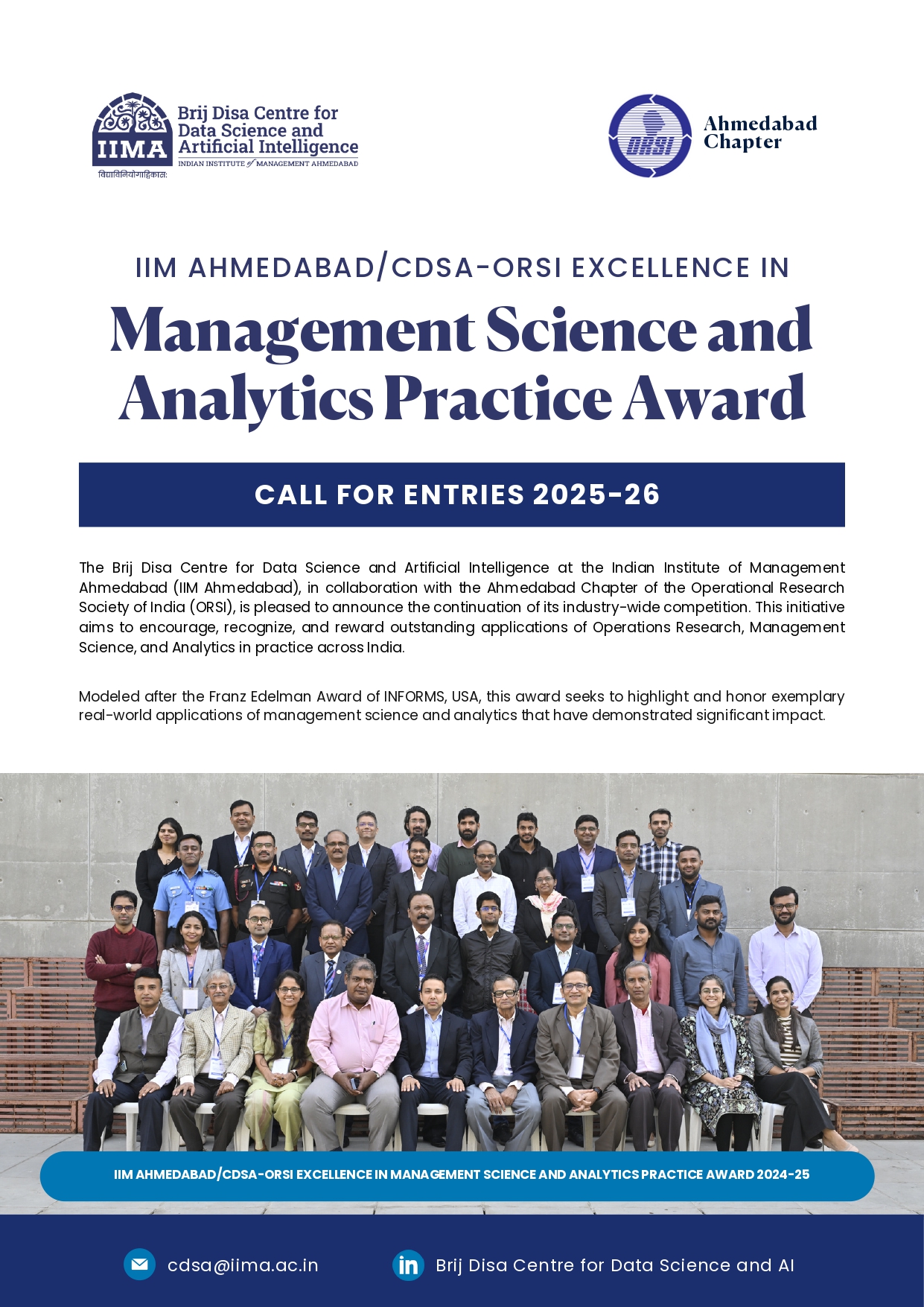
The Indian Institute of Management Ahmedabad (IIMA), in collaboration with the Operational Research Society of India (ORSI), successfully hosted the Ahmedabad chapter of the IIMA/CDSA-ORSI Excellence in Management Science and Analytics Practice Award on 12th January 2025. The event featured the top 5 finalists—SBI, John Deere, Armed Forces of India, JSW Group, and Tata Steel—showcasing innovative projects that demonstrated tangible outcomes such as cost savings, revenue growth, and business innovation. With insightful presentations and valuable inputs from an esteemed jury, the competition highlighted the transformative power of management science and analytics in addressing real-world challenges.
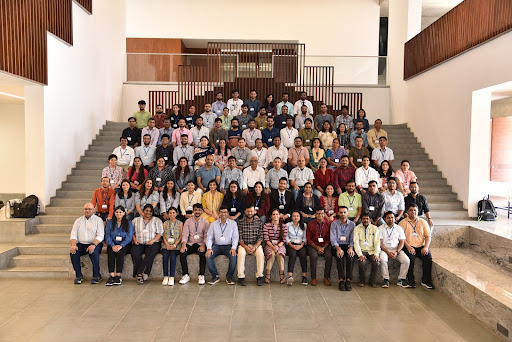
The first edition of the Workshop on Data Science and Artificial Intelligence was conducted at the Brij Disa Centre for Data Science and Artificial Intelligence at the Indian Institute of Management, Ahmedabad. The summer school saw participation from more than 100 participants from both industry and academia and focused on upskilling them with knowledge about cutting-edge techniques in modern applied Statistics, Data Science, and Artificial Intelligence.
Workshop Chairpersons: Prof. Dhiman Bhadra and Prof. Karthik Sriram
Course Instructors: Prof. Ankur Sinha, Prof. Samrat Roy, Prof. Diptesh Ghosh, Prof. Arnab Laha and Prof. Adrija Majumdar
Guest Speakers: Deep Mukherjee (BCG), Kamiya Motwani (Walmart Global Tech) and Rahim Baig (Zalando - Germany)
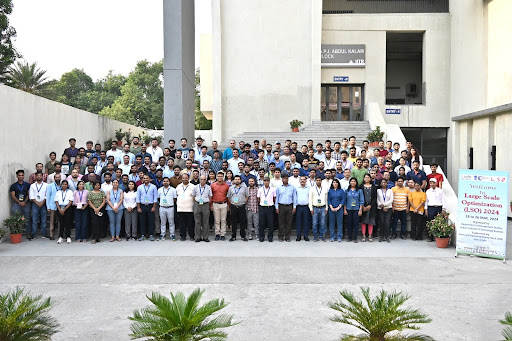
The Brij Disa Centre for Data Science and Artificial Intelligence at IIM Ahmedabad, in collaboration with IIT Roorkee, organized the fourth Large Scale Optimization (LSO) Summer School from May 18-26, 2024. This event attracted academics and industry professionals, focusing on optimization techniques in operations research. Participants learned to manage complex problems in fields like supply chain management and logistics through methods such as relaxation and decomposition. The program also encouraged the submission of original research, fostering innovation and collaboration among researchers and practitioners in large-scale optimization.
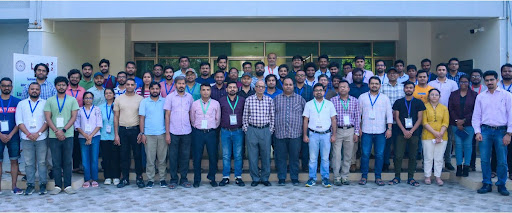
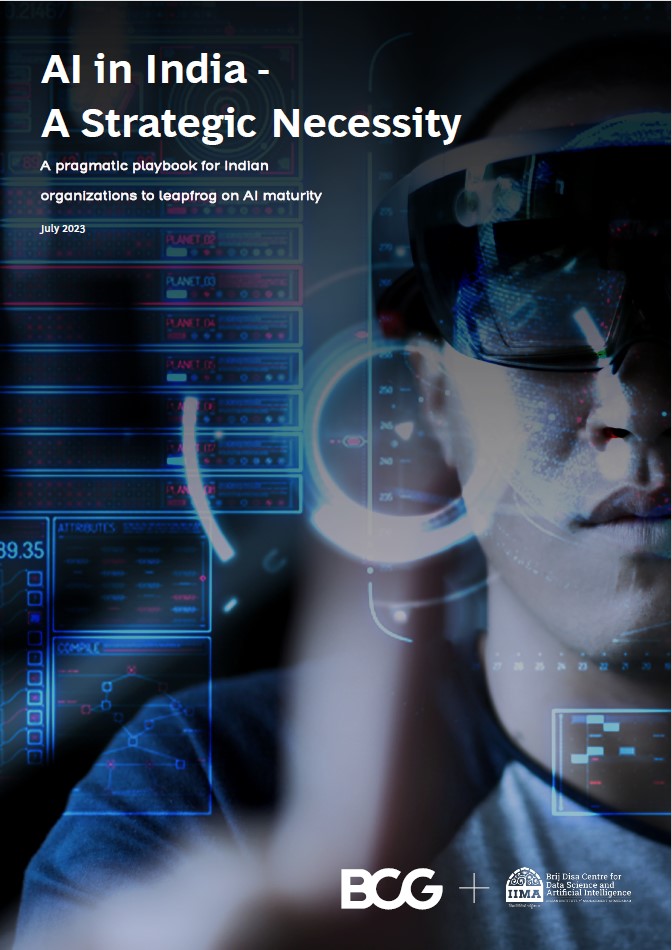
The report "AI in India - A Strategic Necessity," jointly released by Brij Disa Centre for Data Science and AI (CDSA) and BCG X, evaluates the AI readiness of Indian businesses across BFSI, Consumer Goods, and Industrial Goods sectors. Based on a study of 130 companies and insights, the report categorizes organizations into Leaders, Leapfroggers, Steady Followers, and Laggards, highlighting the critical role of AI maturity in driving business success.
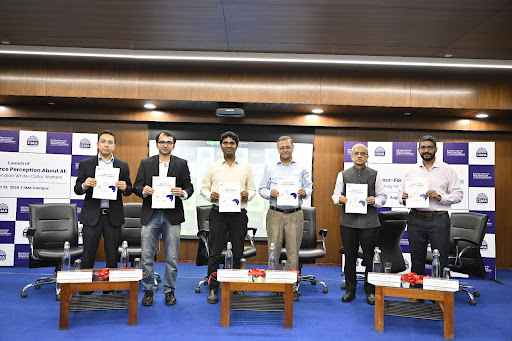
Labour-force perception about AI report
The report, "Labour-force Perception about AI - A Study on Indian White-collar Workers," was launched at IIMA by the Brij Disa Centre for Data Science and AI (CDSA) in partnership with the Wadhwani Foundation. It explores the evolving perceptions of AI among India's white-collar workforce. The study shares insights from multiple interviews and outlines future directions.
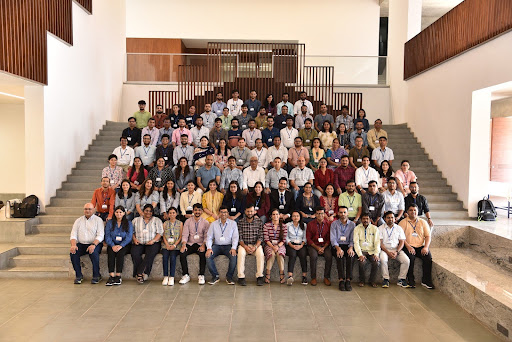
The first edition of the Workshop on Data Science and Artificial Intelligence was conducted at the Brij Disa Centre for Data Science and Artificial Intelligence at the Indian Institute of Management, Ahmedabad. The summer school saw participation from more than 100 participants from both industry and academia and focused on upskilling them with knowledge about cutting-edge techniques in modern applied Statistics, Data Science, and Artificial Intelligence.
Workshop Chairpersons: Prof. Dhiman Bhadra and Prof. Karthik Sriram
Course Instructors: Prof. Ankur Sinha, Prof. Samrat Roy, Prof. Diptesh Ghosh, Prof. Arnab Laha and Prof. Adrija Majumdar
Guest Speakers: Deep Mukherjee (BCG), Kamiya Motwani (Walmart Global Tech) and Rahim Baig (Zalando - Germany)
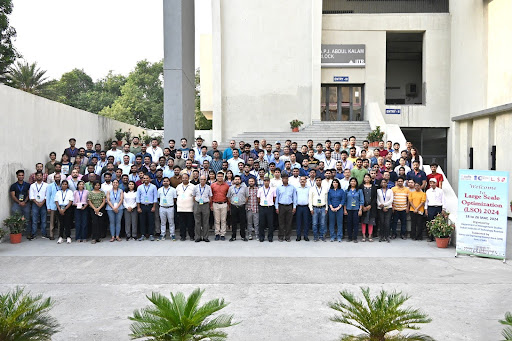
LSO @2024
The Brij Disa Centre for Data Science and Artificial Intelligence at IIM Ahmedabad, in collaboration with IIT Roorkee, organized the fourth Large Scale Optimization (LSO) Summer School from May 18-26, 2024. This event attracted academics and industry professionals, focusing on optimization techniques in operations research. Participants learned to manage complex problems in fields like supply chain management and logistics through methods such as relaxation and decomposition. The program also encouraged the submission of original research, fostering innovation and collaboration among researchers and practitioners in large-scale optimization.
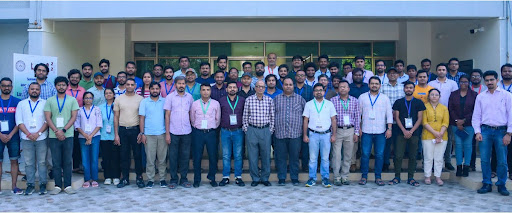
The Brij Disa Centre for Data Science and Artificial Intelligence, in collaboration with the Indian Institute of Technology Kanpur, successfully organised the third LSO Summer School and Conference in April 2023. This event provided a platform for researchers and practitioners to exchange ideas on optimization, fostering collaboration and showcasing recent developments in theory and applications in the field.
Projects
Prof. Karthik Sriram & Prof. Ankur Sinha
Centre Researchers - Dr. Parth Mehta & Dr. Kundan Singh
Abstract:
Crime prediction is a critical component of modern urban safety planning, aiming to forecast when and where crimes are likely to occur so that law enforcement can respond proactively. Traditional methods often struggle with the complex, non-linear dynamics of crime, which are shaped by a web of spatial, temporal, and social factors. To address these challenges, our research adopts a Bayesian modeling framework for the Spatio-Temporal Model of Crime Prediction, tailored to urban street crime data, which offers a principled approach to incorporating prior knowledge and quantifying uncertainty in predictions. The central challenge lies in accurately modeling the spatial and temporal patterns of crime incidents, which tend to be highly irregular and influenced by latent environmental and social factors. To address this, we employ a kernel-based likelihood structure combined with latent variables representing the spatial and temporal components of each crime event. The novelty of the model lies in implementation of adaptive bandwidths and weights, which enable it to capture subtle shifts in crime patterns across neighbourhoods and time periods. This leads to reliable forecasts, providing decision-makers with a clearer view of likely crime hotspots and the uncertainty surrounding predictions. The model is applied to real-world crime data from an Indian city and the resulting predictions can assist law enforcement in resource allocation, hotspot identification, and proactive policing.
Prof. Karthik Sriram & Prof. Ankur Sinha
Centre Researchers - Dr. Parth Mehta & Dr. Kundan Singh
Abstract:
In this project, we designed a novel Kernel Density Estimation (KDE) model for discrete space and time, incorporating adaptive bandwidth and assigned weights to improve the accuracy and relevance of density estimates. In the traditional parametric assumptions, the model adapts to the complexities of real-world data. The theoretical development is implemented by a practical application to coal production data from spatially distributed mines, where daily production is recorded as discrete values. Given the complexity and periodic nature of mine outputs, traditional models are inadequate. To better capture production patterns, the mines are first clustered using unsupervised learning methods, following which KDE is applied within each cluster. Further, we are comparing our KDE model with some existing machine learning models. The aim of the project is to predict which mines will produce coal on a given day and estimate their production quantities. This can support better planning, resource management, and operational decisions.
Prof. Ambrish Dongre
Centre Researchers - Dr. Neaketa Chawla & Harsh Parikh
Abstract:
India has made rapid strides when it comes to access to primary schooling and enrolment. Data from a variety of sources suggests that the percentage of children in the age-group of 6 to 10 years enrolled in school is near universal, and the drop-out rates low. But at the same time, concerns about learning outcomes persist. It is well accepted that a large fraction of enrolled children are below the level expected at the grade in which they are enrolled and lack Foundational Literacy and Numeracy (FLN) skills.
Saajha, an NGO based in Delhi, is attempting to tackle this challenge by focusing on the parents of children attending government primary schools, an approach which is receiving increased attention recently. Saajha onboards parents on their WhatsApp platform, conducts the assessment of their children over telephone and based on their learning level shares appropriate learning content with parents through their WhatsApp chatbot. We are collaborating with Saajha to design and implement multiple experiments to improve their operational efficiency and reduce their cost of engaging with parents.
Centre Researchers - Dr. Dhaval Pujara, Dr. Akash Verma, Shobhit Arora
Abstract:
Mathematical programming-based optimization methods—such as linear programming, mixed-integer programming, and dynamic programming—guarantee optimality but often require substantial computational time and resources, especially when applied to complex, real-world problems. In contrast, approximation-based techniques, including heuristics and metaheuristics (genetic algorithms, simulated annealing, tabu search, ant colony optimization, etc.), offer faster solutions but do not ensure optimality and may struggle with scalability. Our team is developing a bilevel optimization-based decomposition approach to address these limitations and leverage the strengths of both exact and approximation methods. This method can simultaneously apply the classical optimization method and heuristic methods to efficiently solve large-scale, real-world problems across domains such as business, science, and engineering. The BOBD framework is designed to produce high-quality solutions within practical timeframes, making it well-suited for complex optimization tasks.
Centre Researchers - Dr. Dhaval Pujara, Dr. Akash Verma, Shobhit Arora
Abstract:
Effective management of large-scale public gatherings, such as the Kumbh Mela, is vital to safeguard public safety. It plays a crucial role in optimizing operational resources and enhancing the overall visitor experience. To demonstrate effective event management, we use a queueing model to develop a simulation. The simulation study is performed using Arena simulation software. The study focuses on key performance measures such as average queue length and waiting time of a visitor for the ‘snan’. The objective is to evaluate optimal waiting space, improve operational efficiency, identify critical bottlenecks and derive actionable insights for optimizing large-scale event planning. By analyzing crowd dynamics and resource utilization, the study aims to enhance safety protocols and improve the overall experience for visitors.
Centre Researchers - Dr. Dhaval Pujara, Dr. Akash Verma, Shobhit Arora
Abstract:
Mathematical expression recognition is an essential task in scientific document understanding, facilitating the automatic extraction and interpretation of complex notational structures. Despite recent progress, existing systems often fall short when handling the intricate spatial arrangements and semantic hierarchies inherent in mathematical notation. To address these limitations, our research introduces a novel deep learning-based model specifically designed for robust recognition of handwritten and printed mathematical expressions. The model leverages a hybrid encoder-decoder architecture, integrating convolutional neural networks (CNNs) for visual feature extraction with a transformer-based decoder to accurately capture structural dependencies in two-dimensional math layouts.
Prof. Sachin Jayaswal
Centre Researcher - Ashish Talvekar
Abstract:
Today blockchain technologies have wide applications because it is not possible to alter information in the particular block without altering the subsequent blocks. Blockchain technologies are used where decentralized structure, security and privacy are required. Blockchain technology relies heavily on the efficiency of Merkle trees for managing and updating transaction data. In this research, we are trying to take advantage of typical transaction characteristics to better construct the Merkle tree to improve the performance of the blockchain network. It consists of identifying a tree structure with the minimum number of hash transfers over a network required to validate the account data associated with each transaction based on the distribution of all transactions. Using the typical characteristics of transaction distributions, we propose a novel approach to minimize the number of hash transfers over a network required to validate transactions. Our optimization models are formulated as a binary quadratic program (BQP), which we linearize using various linearization techniques. In addition to this we also have our own set of symmetry breaking constraints. To solve this model efficiently, we use the cplex internal benders Benders that utilizes the inherent network flow structure in the separation sub-problems. We use the divide and conquer method to construct a Merkle Tree of large no accounts which significantly improve transaction processing efficiency.
Prof. Anindya S Chakrabarti
Centre Researcher - Vijay V Venkitesh
Abstract:
The Russia-Ukraine war has underscored the vulnerability of global supply chains, particularly in critical sectors like energy and commodities. These disruptions have had far-reaching effects, including in India, where price volatility—especially in coal—has posed significant challenges for firms. This project analyzes Goods and Services Tax (GST) data from an Indian state, offering a unique opportunity to examine large-scale economic networks through detailed business-to-business transaction records. Using network-theoretic approaches, we explore patterns such as community structures while focusing on how production networks absorb and respond to external shocks. A key objective is to understand how firms adjust their pricing strategies in response to coal supply disruptions triggered by global events.
Prof. M P Ram Mohan
Centre Researcher - Prerna Seerwani
Abstract:
Publicly accessible bulk datasets of trademark application and registration information are crucial for enabling comprehensive and data-driven research on the administration of trademark law. Such datasets allow researchers to systematically examine trends, predictability, and potential biases in how trademark provisions are applied in India.
Given the lack of comparable large-scale datasets, empirical scholarship relating to trademarks in India remains very scarce. This position is most critically visible in legal scholarship, empirically studying the functioning and efficacy of trademark systems in India. To alleviate this lacuna and contribute to the empirical literature examining trademark systems, this project aims to create a novel dataset by downloading and collecting examination reports from the online portal of the Indian Trade Marks Registry.
Prof. Tanmoy Majilla
Abstract:
Modern electronic markets are driven by high-frequency trading and the interactions of a vast number of heterogeneous traders, giving rise to complex dynamics that traditional models often fail to capture. These dynamics can lead to emergent behaviors, systemic vulnerabilities, and endogenous market fragility in fast-paced, data-driven environments.
This project develops a mathematical modelling framework to examine how collective trading behaviors influence price formation, liquidity, and overall market stability, while capturing interactions among numerous participants. A key objective is to derive an indicator to quantitatively assess market fragility and stability, identify trader states contributing most to systemic risk, and explore potential regulatory interventions. Using high-frequency market data, the project provides actionable insights for understanding, predicting, and managing risks in modern electronic markets, offering a robust foundation for research and policy design.
Prof. Anirban Banerjee
Abstract:
Over the last decade, the Indian market has seen significant growth in algorithmic trading and more specifically, high-frequency trading (HFT) activity. During this period, we have witnessed a significant change in the trading landscape as presently close to half of the trading volume in the stock exchanges is contributed by algorithms. This rise has not always been smooth as there have been calls for regulations to restrict algorithmic trading activity due to the fear of probable market manipulation.
Latency is considered one of the most important market parameters for HFTs. Using a large novel dataset of order and trade level data from the NSE, we would like to inspect how the latency in the Indian market has changed and if that has caused any shift in the way HFTs operate. We would also like to observe how the different market quality parameters have evolved over this time.
Prof. Swanand Deodhar and Prof. Samrat Gupta
Abstract:
The study is on the nuanced impact of dynamic rewards in creative crowdsourcing. It shall include randomized trials during contests with dynamically adjusted rewards. It shall also combine dynamic rewards with feedback. This multifaceted approach aims to understand how variations in rewards, feedback, and their combination influence designer behavior, submission diversity, and solution quality. The study will also explore the implications of dynamic rewards and the increasing role of AI-based tools in evaluating creative submissions, contributing to discussions on optimizing creative crowdsourcing platforms.
Prof. Anindya Chakrabarti
Abstract:
Financial markets exhibit non-trivial comovement and dependency structure. The standard approach in the finance literature is to consider the market in its aggregate form. A more recent 'data'-oriented approach emphasizes a more granular decomposition of the market so that the aggregate dynamics can be broken down into contributions arising from individual assets. This leads to two analytical problems. First, one has to necessarily deal with a large amount of data such that the process scales with the volume of data (large N and large T where T>>N). Two, analyzing such a large volume of data requires toolkits which are at the intersection of econometrics and machine learning. In this project, the goal is to construct large scale financial networks based on multivariate time series data to capture the dynamics of the system. The main idea is to provide an algorithmic approach to convert time series into networks such that the properties of time series are also inherited by the resulting network. The spectral structure of the comovement network is known to capture, at least partially, the booms and busts in the markets. Here, we take up two specific problems.One, how reliably does the spectral structure reflect the system for the case where T~N. Two, a large chunk of the literature on networks construction depends on bivariate modelling which is subject to failure due to multiple hypothesis testing. Therefore, an imminent question is how to construct a network with a direct multivariate model.
Prof. Ambrish Dongre and Dr. Neaketa Chawla
India has made rapid strides in ensuring access to primary schooling. Data from a variety of sources also suggests that the percentage of children in the age-group of 6 to 10 years enrolled in school is near universal, and the drop-out rates low. However, concerns about learning outcomes persist. It is well accepted that a large fraction of enrolled children are way below the level expected at the grade in which they are enrolled.
Saajha, a non-governmental organization, is attempting to tackle this challenge by focusing on the parents of children attending government primary schools. This approach, of reaching out to parents and involving them in child’s education, has been receiving increased attention recently with many organizations and governments undertaking such efforts.
Saajha first conducts community drives through which they on-board parents on their Whatsapp platform. After this they conduct Hindi and Math assessments of children over the telephone. Depending upon the learning level of the child, educational content related to Foundational Literacy and Numeracy (FLN) skills is shared over WhatsApp with respective parents. Parents are expected to show this content to their children. Saajha subsequently conducts periodic assessments to check whether the learning level is improving.
These assessments are conducted by 'Saajhedars,' parents who have previously used Saajha's WhatsApp platform. Parents can also call the `Saajha’ helpline number for admission-related inquiries and other information regarding government schools in Delhi.
Through this project, we are collaborating with Saajha to design and implement multiple experiments to improve their operational efficiencies.
Prof. M P Ram Mohan
Publicly accessible bulk datasets of trademark application and registration information are crucial for enabling comprehensive and data-driven research on the administration of trademark law. Such datasets allow researchers to systematically examine trends, predictability, and potential biases in how trademark provisions are applied in India.
Given the lack of comparable large-scale datasets, empirical scholarship relating to trademarks in India remains very scarce. This position is most critically visible in legal scholarship, empirically studying the functioning and efficacy of trademark systems in India. To alleviate this lacuna and contribute to the empirical literature examining trademark systems, this project aims to create a novel dataset by downloading and collecting examination reports from the online portal of the Indian Trade Marks Registry. The project produced following research outputs:
Prof: Sachin Jayaswal
A Merkle tree, also called a hash tree, is a well-known tool to efficiently validate a data element in a set without revealing the entire set. It thus forms a critical component of blockchain technology as it enables secure validation of blockchain transactions. It stores the balance of each blockchain account as a hash value on its leaf nodes, which must be updated after each transaction. The efficiency of hash updates on a Merkle tree depends on the relative distribution of the accounts on the tree: as two accounts that frequently transact between them move closer to the root, fewer nodes need to be read and updated. In this work, we aim to develop an integer programming-based mathematical model for constructing a Merkle tree that can be efficiently updated. Further, we aim to develop algorithms to solve the resulting model efficiently.
Prof. Swanand Deodhar and Prof. Samrat Gupta
Prof. Aditya Christopher Moses
The future of work is a critical aspect for many organizations. A 2020 report by the World Economic Forum suggests that among the various challenges faced by organization one of the most critical areas is skill gaps. They argue that skill gaps continue to remain high as in-demand skills across jobs change in the short term. The top skills and skill groups which employers see as rising in prominence in the lead up to 2025 include groups such as critical thinking and analysis as well as problem-solving, and skills in self-management such as active learning, resilience, stress tolerance and flexibility. On average, companies estimate that around 40% of workers will require reskilling of six months or less and 94% of business leaders report that they expect employees to pick up new skills on the job, a sharp uptake from 65% in 2018.
The changing nature of work and the exponential technology development imply that employees need to constantly re-skill and up-skill. In the current environment, while knowledge can be accessed via multiple sources the behaviours to develop oneself become more important. What behaviours will organizations require for ensuring they have a workforce that can reskill and upskill exponentially? This will be the primary area of research for this study.
Using a data-driven approach, this study uses surveys and NLP to understand which behavioural traits enable re-skilling at pace. We will employ text-mining methods and techniques to identify behavioural traits that help in re-skilling. The insights from this will be further validated and tested using a survey instrument administered to a large sample of individuals
Prof. Anindya Chakrabarti
Financial markets exhibit non-trivial comovement and dependency structure. The standard approach in the finance literature is to consider the market in its aggregate form. A more recent 'data'-oriented approach emphasizes a more granular decomposition of the market so that the aggregate dynamics can be broken down into contributions arising from individual assets. This leads to two analytical problems. First, one has to necessarily deal with a large amount of data such that the process scales with the volume of data (large N and large T where T>>N). Two, analyzing such a large volume of data requires toolkits which are at the intersection of econometrics and machine learning. In this project, the goal is to construct large scale financial networks based on multivariate time series data to capture the dynamics of the system. The main idea is to provide an algorithmic approach to convert time series into networks such that the properties of time series are also inherited by the resulting network. The spectral structure of the comovement network is known to capture, at least partially, the booms and busts in the markets. Here, we take up two specific problems. One, how reliably does the spectral structure reflect the system for the case where T~N. Two, a large chunk of the literature on networks construction depends on bivariate modelling which is subject to failure due to multiple hypothesis testing. Therefore, an imminent question is how to construct a network with a direct multivariate model.
Prof. Anirban Banerjee
Over the last decade, the Indian market has seen significant growth in algorithmic trading and more specifically, high-frequency trading (HFT) activity. During this period, we have witnessed a significant change in the trading landscape as presently close to half of the trading volume in the stock exchanges is contributed by algorithms. This rise has not always been smooth as there have been calls for regulations to restrict algorithmic trading activity due to the fear of probable market manipulation.
Latency is considered one of the most important market parameters for HFTs. Using a large novel dataset of order and trade level data from the NSE, we would like to inspect how the latency in the Indian market has changed and if that has caused any shift in the way HFTs operate. We would also like to observe how the different market quality parameters have evolved over this time.
Prof. Ankur Sinha
Hyperparameter tuning in the area of machine learning is often achieved using naive techniques, such as random search and grid search that only lead to an approximate set of hyperparameters. Although techniques such as Bayesian optimization perform an intelligent search on the domain of hyperparameters, it does not guarantee an optimal solution. A major drawback of most of these approaches is that as the number of hyperparameters increases, the search domain increases exponentially, thereby increasing the computational cost and making the approaches slow. The hyperparameter optimization problem is inherently a bilevel optimization task, and there exist studies that have attempted bilevel solution methodologies for solving this problem. These techniques often assume a unique set of weights that minimizes the loss on the training set. Such an assumption is violated by deep learning architectures. Our study is on gradient-based bilevel optimization method for solving the hyperparameter optimization problem. The method is general and can be easily applied to any class of machine learning algorithms that involve continuous hyperparameters.
Prof. Anuj Kapoor
Conversational AI Chatbots are rapidly evolving as new technologies with both business potential and customer reactance. This study exploits large-scale field experiment data on thousands of customers who are randomized to receive highly structured outbound sales calls from chatbots. We vary features like the gender of the bot along with the formal or informal tone of the bot. In this paper, we propose a dynamic outbound call experimentation policy. The proposed approach extends multi-armed bandit (MAB) algorithms, from statistical machine learning, to include microeconomic choice theory. Our automated outbound call policy solves this MAB problem using a scalable distribution-free algorithm. Beyond the actual experiment, we plan to counterfactual simulations to evaluate a range of alternative model specifications and allocation rules in MAB policies.
Prof. Anuj Kapoor
Artificial intelligence(AI) assisted tools are increasingly being used in health care contexts to provide advice and motivation. But whether AI can be a good or even better substitute for human involvement in these contexts is an open question. We provide empirical evidence to answer this question specifically in the context of fitness tracking mobile applications (apps). In addition to facilitating the tracking of activity and food intake, such apps provide advice and motivation in the form of targeted messages to their consumers, and this can be done through human coaches or an AI coach. An AI coach allows these apps to scale their offerings to a larger number of consumers, available on demand to consumers, and potentially more finely targeted by leveraging vast amounts of data. On the other hand, human coaches might be better placed to show empathy, and consumers might also feel more accountable to humans. We compare human and AI coaches on their effectiveness in helping consumers achieve their weight-loss goals. Our empirical analysis is in the context of a large-scale mobile app that offers consumers different levels of subscription plans with human and AI coaches respectively, and specifically compares adopters of the two kinds of plans on their weight loss and goal achievement. We address the potential self-selection in plans by employing a matching-based approach. We find, for our sample of almost 65000 consumers that human-based plans do better than those in AI-based plans in helping them achieve their goals, but that this differs by consumer characteristics including age, gender and body mass index (BMI).
Prof. Hyokjin Kwak
Major empirical methods: web scrapping, data pre-processing, independent t-test, machine learning classification method (CNN and ResNet-32).
This project aims to study how anthropomorphized ‘brand new’ and ‘used’ toaster products affect consumer purchase or bidding behaviour. To do this, I scrapped all the toaster data information like product name, number of consumers watching the product, bidding details etc., from eBay website, toaster products were then manually labelled as Anthropomorphized "AB" or Non- Anthropomorphized "Non-AB." Exploratory data analysis (EDA) was used to look at the attributes of the data. IBM SPSS software is also used to analyse the Independent sample t-test. This test compares the means of two independent groups, AB and Non-AB, to see if there is statistical evidence that the relevant attribute means are significantly different.
Also, multiple deep learning approaches were used to classify the AB and NAB toaster images.
Prof. Hyokjin Kwak
Major empirical methods: web scrapping, data analysis, sentimental analysis.
The objective of this study is to check the purchasing behaviour of consumers in response to creative advertisements that have been posted on Amul's twitter handles and to also apply sentimental classification techniques to the comments that have been posted on Amul's twitter handles. Initially, I compiled all available data on Amul's most successful advertisements from 2019 to 2021, which can be found on the company's website and neatly labeled according to year. Information about advertisements was then culled from the Amul Twitter account and matched with captions taken directly from the company's website. The properties of the data were investigated using exploratory data analysis (EDA) methods. IBM SPSS is also used to analyse the results of the independent sample t-test, which compares the means of two groups to determine whether or not there is statistical evidence of the relevant attributes are significantly different. In addition to that, a sentimental analysis was carried out on the user comments left on the advertisement that was uploaded to Amul's Twitter handle
Prof. Hyokjin Kwak
Major empirical methods: web scrapping, data pre-processing, sentimental and emotions analysis.
This research will compare the emotional and sentimental analysis of book reviews that were posted on Amazon.in (India) and Amazon.com (US) by taking into consideration of other characteristics such as book ratings, book cost, discounts available on the book, etc. This study will focus mostly on the sentiments and emotions expressed in Amazon USA and India book reviews. I explored various algorithms like VADER (Valence Aware Dictionary and Sentiment Reasoner), Textblob, SentiBERT etc. to detect the sentiments present in the product reviews also explored emotions like happy, fear, disgust, anticipation, joy, sadness, surprise, and trust.
Prof. Hyokjin Kwak
Major empirical methods: web scrapping, data pre-processing, text analysis which includes identifying bi-gram and trigram words
In this study, I will be performing an analysis of the textual contents, beginning with the reviews of the product and continuing all the way through to the purchase recommendation. In addition, a semi-automatic method will be utilised to extract terms from the text in reviews, and a knowledge graph will be utilised. The extracted phrases were connected to the various technical aspects of the items. After that, vector representations of the graph elements will be trained, which will result in a significant improvement in the overall quality of the recommendations. I intend to look into Adaptive Text Rank, which is based on a set of technical characteristics and a collection of sentiment words; the SOTA BERT model, which matches terms with the technical features of the products; the TransE method, which trains vector representations of graph elements; and the ABAE method, which highlights important characteristics for products based on a collection of reviews.
Prof. Hyokjin Kwak
Major empirical methods: web scrapping, data pre-processing, text analysis which includes identifying bi-gram and trigram words, collection of large labelled dataset of fake and non- fake reviews from official sources.
The most recent AI text generation models, such as GPT-2 and GPT-3, along with a variety of transformer models, can be utilised to generate fake computer-generated reviews. Researchers in the field of data science have demonstrated how artificial intelligence reviews may be generated and identified with the use of machine learning. Additionally, fake reviews can be purchased in bulk from various sources. Researchers have uncovered a wide range of potential traits that can help humans and models determine the difference between a fake review and a genuine one. These features were discovered after studying fake reviews in great detail. Because fake reviews frequently utilise the same language, the review content itself is generally considered to be the most important aspect. This is especially true in cases where multiple reviews were written by the same individual, firm, or other sources. Review length, Sentiment, Helpfulness, Reviews per user, and Verified review are some of the often-used features that can be noticed in studies on fake review detection. In order to create a model that is able to differentiate between the fake reviews that are posted on Amazon.com and Amazon.in, I will be conducting research into text-classification algorithms and NLP pre-processing techniques, such as count vectorization and TF-IDF, as well as machine and deep learning techniques
Prof. Hyokjin Kwak
Major empirical methods: web scrapping, data pre-processing, text analysis, Latent Dirichlet Allocation (LDA)
The technique of automatically identifying topics that are present in a text item and deriving hidden patterns that are represented by a text corpus is referred to as topic modelling. The usage of topic models is beneficial for a variety of tasks, including the clustering of texts, the organisation of huge blocks of textual data, the recovery of information from unstructured text, and the selection of features.
My goal here is to extract a set number of relevant word groups from the reviews based on sentiment, i.e., positive, negative, or neutral. These word groups are essentially the issues that will aid in determining what the customers are actually talking about in the reviews. This will inform us which subjects are frequently addressed by Indian and American reviews when they favour or dislike the product. This can be expanded upon in terms of emotions as well.
Prof. Jeevant Rampal
Auctions are often used to sell property rights for liquor licenses, spectrum licenses, land and mineral rights, and construction projects etc. This project investigates potential improvements in these auctions using a computational data-driven approach. The first part of this project will be to collect primary data of the participants and their choices in auctions. Subsequently, using the game-theoretic properties of the chosen auction design, we will computationally estimate the true (unobservable) value distribution across players of the object(s) being auctioned (e.g., liquor licenses). The estimation method used will be non-parametric “distance minimization” between the observed out-of-sample distribution of bids, and the predicted out-of-sample distribution of bids using optimally calibrated parameter values. E.g., Athey, Levin, and Seira (QJE 2011) use their estimated model to make comparative static predictions and test that for fit against data from timber auctions.
Finally, to analyse which auction design would have best met the various aims of the auction designer, we will use the calibrated model, parameters, and the estimated valuations of the bidders. In particular, using these we will simulate the revenue, efficiency, and other metrics of importance for different auction designs. In addition to the use of simulation described above, to analyse alternate auction designs, we will use simulations of variations of the estimated model, parameters (like risk aversion, budgets etc.), and value distributions to analyse the different rates with which different auction designs can meet the various possible aims of the auction designer.
Prof. Sachin Jayaswal
We propose to study a multiperiod interdiction problem, in which the leader (attacker) with a limited interdiction budget decides the sequence of facilities to interdict (destroy) over time so as to inflict the maximum cumulative damage to the follower. The follower's objective is to serve a given set of demand points from the surviving subset of facilities the minimum cumulative cost across all periods. for this, his decisions include the assignments of demand nodes to the surviving facilities and the allocation of his limited budget to the revival of interdicted facilities and the protection of the surviving facilities against their interdiction in the future periods. The multi-period version of the problem, which is the focus of the proposed study, presents additional complexity due to the leader's interdiction decisions constrained by the follower's protection decisions. The objective of the proposed study is to design efficient exact solution methods for this challenging bilevel integer program.
Prof. Samrat Gupta
The Information and Communication Technology (ICT) provides users unparalleled access to information from around the globe. In spite of demographic differences, people can communicate, express and evolve their opinions on topics ranging from politics to culture. The wide-ranging information exchange on digital media can lead to two scenarios viz. formation of public sphere or formation of echo chambers. While the public sphere, which promotes greater diversity, is a well-researched domain, substantially less research has been conducted on echo chambers in relation to socio-cultural events. Despite the huge affirmative impact of socio-cultural events on society, the proliferation of controversies around them and reinforcement through echo chambers is collectively having malefic effects on societies. Recent controversies around socio-cultural products such as movies, painting, books, cartoons, etc. resulted in serious outcomes. For example, Indian movie Padmavat brought polarization of public perception which further reinforced through echo chambers and escalated into widespread agitations. It led to mass destruction of property and human suffering during agitation. We believe this represents a mounting problem for society, one that is likely to intensify in the era of social media. Thus, understanding the causes, symptoms and consequences of socio-cultural polarization is critical and would be valuable for developing interventions to reduce unhealthy societal and organizational polarisations.
Prof. Sobhesh kumar Agarwalla and Prof Vineet Virmani
The proposed research project on modeling implied volatility (IV) and understanding the information content of option prices is part of our larger research agenda on studying ways to quantify uncertainty in financial markets, focusing on India. Traders in options markets do not usually quote option prices, but the volatility implied by them. IV is that volatility input to the famous Black-Scholes option pricing formula such that the Black-Scholes prices match the market price of the options. It has been observed that IV is not a constant but varies systematically with strike/delta and expiration date. The shape of the observed relationship between implied volatility and strike is called volatility smile or skew. In this project, we plan to explore various ways of modeling the dynamics of volatility smile using variants of state-space models and the Kalman Filter.The proposed research project on modeling implied volatility (IV) and understanding the information content of option prices is part of our larger research agenda on studying ways to quantify uncertainty in financial markets, focusing on India. Traders in options markets do not usually quote option prices, but the volatility implied by them. IV is that volatility input to the famous Black-Scholes option pricing formula such that the Black-Scholes prices match the market price of the options. It has been observed that IV is not a constant but varies systematically with strike/delta and expiration date. The shape of the observed relationship between implied volatility and strike is called volatility smile or skew. In this project, we plan to explore various ways of modeling the dynamics of volatility smile using variants of state-space models and the Kalman Filter.
Prof. M P Ram Mohan
This project aims to explore the impact of Artificial Intelligence in the Indian legal systems. Specifically, the study explores Artificial Intelligence in contract management, courts and management of cases, impact of AI in corporate law and governance, etc.
Prof. Swanand Deodhar and Prof. Samrat Gupta
The project "Effects of Dynamic Rewards on Solver Efforts in Creative Crowdsourcing" aims to examine the effects of dynamic reward as an incentive mechanism in the creative contest landscape. Prior work has examined the role of reward, articulating a variety of effects. However, the typical approach is that the reward gets fixed at the start of the contest and does not change during the contest period. Our study aims to empirically relax this boundary condition. To this end, we plan to conduct a randomized field experiment in which rewards are announced at the start of the contest, and we offer different incentives during the contest. The findings from this study will contribute to the existing literature on crowdsourcing, creativity, and motivation, offering practical insights for both platform administrators and organizations leveraging creative crowdsourcing. The study will benefit the seekers (organizations) and the solvers (individuals). Ultimately, this research seeks to inform the design of various reward structures that enhance solver engagement, foster creativity, and optimize outcomes in the context of creative CCs.




| Name | University |
| Sobhesh Kumar Agarwalla | IIM Ahmedabad |
| Cheong Siew Ann | Nanyang Technological University |
| Anirban Banerjee | IIM Ahmedabad |
| Arindam Banerjee | IIM Ahmedabad |
| Dhiman Bhadra | IIM Ahmedabad |
| Indranil Bose | IIM Ahmedabad |
| Anindya S. Chakrabarti | IIM Ahmedabad |
| Swanand Deodhar | IIM Ahmedabad |
| Anil Deolalikar | UC Riverside |
| Samrat Gupta | IIM Ahmedabad |
| Sachin Jayaswal | IIM Ahmedabad |
| Anuj Kapoor | IIM Ahmedabad |
| Hyokjin Kwak | IIM Ahmedabad |
| Andrea Lodi | École Polytechnique de Montréal |
| Thomas Lux | Kiel University |
| Tanmoy Majilla | IIM Ahmedabad |
| Adrija Majumdar | IIM Ahmedabad |
| Pekka Malo | Aalto University School of Business |
| Sheri Markose | University of Essex |
| Mohsen Mohaghegh | IIM Ahmedabad |
| M P Ram Mohan | IIM Ahmedabad |
| Aditya Christopher Moses | IIM Ahmedabad |
| Soumya Mukhopadhyay | IIM Ahmedabad |
| Sundaravalli Narayanaswami | IIM Ahmedabad |
| Viswanath Pingali | IIM Ahmedabad |
| Sudha Ram | University of Arizona |
| Jeevant Rampal | IIM Ahmedabad |
| Neelkant Rawal | Wells Fargo |
| Sriram Sankaranarayanan | IIM Ahmedabad |
| Suprateek Sarker | University of Virginia |
| Pankaj Setia | IIM Ahmedabad |
| Avinash Sharma | IIIT Hyderabad |
| Peng Shi | Wisconsin School of Business |
| Hemant Kumar Singh | University of New South Wales |
| Pranav Singh | IIM Ahmedabad |
| Ankur Sinha | IIM Ahmedabad |
| Sitabhra Sinha | The Institute of Mathematical Science, Chennai |
| Chetan Soman | IIM Ahmedabad |
| Karthik Sriram | IIM Ahmedabad |
| Anish Sugathan | IIM Ahmedabad |
| Abhishek Tripathi | Perfios |
| Arvind Tripathi | University of Auckland Business School |
| Ellapulli Vasudevan | IIM Ahmedabad |
| Sanjay Verma | IIM Ahmedabad |
| Name | Designation |
| Present Members | |
| Neaketa Chawla | Post-doctoral Research Associate |
| Nebu Varghese | Pre-doctoral Research Associate |
| Rahul Sharma | Pre-doctoral Research Associate |
| Saswot Nayak | Pre-doctoral Research Associate |
| Ashish Talvekar | Pre-doctoral Research Associate |
| Harsh Parikh | Pre-doctoral Research Associate |
| Chaitanya Agarwal | Pre-doctoral Research Associate |
| Lucky Khanna | Pre-doctoral Research Associate |
| Vijay V Venkitesh | Pre-doctoral Research Associate |
| Romika Dhingra | Pre-doctoral Research Associate |
| Dibyajyoti Chakrabarti | Pre-doctoral Research Associate |
| Arzoo Narang | Post-doctoral Research Associate |
| Amita Todkar | Pre-doctoral Research Associate |
| Shobit Arora | Pre-doctoral Research Associate |
| Dhaval Pujara | Post-doctoral Research Associate |
| Tanya Gauni | Pre-doctoral Research Associate |
| GVK Sai Sarath | Intern |
| Arka Provo Sarkar | Intern |
| Priyanshu Kumar | Intern |
| Shubhankar Sahu | Intern |
| Aritra Banerjee | Intern |
| Jaydeep Gohel | Centre Secretary |
|
Past Members |
|
| Kushal Bhalla | Post-doctoral Research Associate |
| Shubhi Gehlot | Intern |
| Priyanshu Kumar | Intern |
| Shubhankar Sahu | Intern |
| Aritra Banerjee | Intern |
| Lucky Khanna | Pre-doctoral Research Associate |
| Rohan Harchandani | Pre-doctoral Research Associate |
| Sayantan Pramanick | Pre-doctoral Research Associate |
| Rahul Sharma | Pre-doctoral Research Associate |
| GVK Sai Sarath | Intern |
| Arnab Chakrabarti | Post-doctoral Research Associate |
| Vani Dwivedi Pandya | Pre-doctoral Research Associate |
| Prince Roy | Pre-doctoral Research Associate |
| Shivam Kumar | Pre-doctoral Research Associate |
| Viswash Mehta | Pre-doctoral Research Associate |
| Kulvinder Kaur | Post-doctoral Research Associate |
| Satender | Pre-doctoral Research Associate |
| Vaishnav Garg | Pre-doctoral Research Associate |
| Sayantan Pramanick | Pre Doctoral Research Associate |
| Tanya Garg | Pre Doctoral Research Associate |
| Name | University |
| Abhishek Tripathi | Perfios |
| Aditya Christopher Moses | IIM Ahmedabad |
| Adrija Majumdar | IIM Ahmedabad |
| Ambrish Dongre | IIM Ahmedabad |
| Andrea Lodi | École Polytechnique de Montréal |
| Ankur Sinha | IIM Ahmedabad |
| Anil Deolalikar | UC Riverside |
| Anindya S. Chakrabarti | IIM Ahmedabad |
| Anirban Banerjee | IIM Ahmedabad |
| Anish Sugathan | IIM Ahmedabad |
| Anuj Kapoor | IIM Ahmedabad |
| Arindam Banerjee | IIM Ahmedabad |
| Arvind Tripathi | University of Auckland Business School |
| Avinash Sharma | IIIT Hyderabad |
| Cheong Siew Ann | Nanyang Technological University |
| Chetan Soman | IIM Ahmedabad |
| Dhiman Bhadra | IIM Ahmedabad |
| Ellapulli Vasudevan | IIM Ahmedabad |
| Hemant Kumar Singh | University of New South Wales |
| Hyokjin Kwak | IIM Ahmedabad |
| Indranil | IIM Ahmedabad |
| Jeevant Rampal | IIM Ahmedabad |
| Karthik Sriram | IIM Ahmedabad |
| Mohsen Mohaghegh | IIM Ahmedabad |
| M P Ram Mohan | IIM Ahmedabad |
| Neelkant Rawal | Wells Fargo |
| Pankaj Setia | IIM Ahmedabad |
| Peng Shi | Wisconsin School of Business |
| Pekka Malo | Aalto University School of Business |
| Pranav Singh | IIM Ahmedabad |
| Pritha Dev | IIM Ahmedabad |
| Sachin Jayaswal | IIM Ahmedabad |
| Samrat Gupta | IIM Ahmedabda |
| Sanjay Verma | IIM Ahmedabda |
| Sheri Markose | University of Essex |
| Sitabhra Sinha | The Institute of Mathematical Science, Chennai |
| Sobhesh Kumar Agarwalla | IIM Ahmedabad |
| Soumya Mukhopadhyay | IIM Ahmedabad |
| Sriram Sankaranarayanan | IIM Ahmedabad |
| Sudha Ram | University of Arizona |
| Sundaravalli Narayanaswami | IIM Ahmedabad |
| Suprateek Sarker | University of Virginia |
| Swanand Deodhar | IIM Ahmedabad |
| Tanmoy Majilla | IIM Ahmedabad |
| Thomas Lux | Kiel University |
| Viswanath Pingali | IIM Ahmedabad |
| Name | University |
| Abhishek Tripathi | Perfios |
| Aditya Christopher Moses | IIM Ahmedabad |
| Adrija Majumdar | IIM Ahmedabad |
| Ambrish Dongre | IIM Ahmedabad |
| Andrea Lodi | École Polytechnique de Montréal |
| Ankur Sinha | IIM Ahmedabad |
| Anil Deolalikar | UC Riverside |
| Anindya S. Chakrabarti | IIM Ahmedabad |
| Anirban Banerjee | IIM Ahmedabad |
| Anish Sugathan | IIM Ahmedabad |
| Arindam Banerjee | IIM Ahmedabad |
| Arvind Tripathi | University of Auckland Business School |
| Avinash Sharma | IIIT Hyderabad |
| Cheong Siew Ann | Nanyang Technological University |
| Chetan Soman | IIM Ahmedabad |
| Dhiman Bhadra | IIM Ahmedabad |
| Ellapulli Vasudevan | IIM Ahmedabad |
| Hemant Kumar Singh | University of New South Wales |
| Indranil | IIM Ahmedabad |
| Jeevant Rampal | IIM Ahmedabad |
| Karthik Sriram | IIM Ahmedabad |
| Mohsen Mohaghegh | IIM Ahmedabad |
| M P Ram Mohan | IIM Ahmedabad |
| Neelkant Rawal | Wells Fargo |
| Pankaj Setia | IIM Ahmedabad |
| Peng Shi | Wisconsin School of Business |
| Pekka Malo | Aalto University School of Business |
| Pranav Singh | IIM Ahmedabad |
| Pritha Dev | IIM Ahmedabad |
| Rajat Sharma | IIM Ahmedabad |
| Sachin Jayaswal | IIM Ahmedabad |
| Samrat Gupta | IIM Ahmedabad |
| Sanjay Verma | IIM Ahmedabad |
| Saravanan A | IIM Ahmedabad |
| Sheri Markose | University of Essex |
| Sitabhra Sinha | The Institute of Mathematical Science, Chennai |
| Sobhesh Kumar Agarwalla | IIM Ahmedabad |
| Soumya Mukhopadhyay | IIM Ahmedabad |
| Sudha Ram | University of Arizona |
| Sundaravalli Narayanaswami | IIM Ahmedabad |
| Suprateek Sarker | University of Virginia |
| Swanand Deodhar | IIM Ahmedabad |
| Tanmoy Majilla | IIM Ahmedabad |
| Thomas Lux | Kiel University |
| Viswanath Pingali | IIM Ahmedabad |
| Name | Designation |
| Neaketa Chawla | Centre Coordinator. |
| Dr. Dhaval Pujara | Post-doctoral Research Associate |
| Dr. Parth Mehta | Post-doctoral Research Associate |
| Dr. Kundan Singh | Post-doctoral Research Associate |
| Dr. Akash Verma | Post-doctoral Research Associate |
| Nantu Kumar Bisui | Pre-doctoral Research Associate |
| Chhavi Sharma | Post-doctoral Research Associate |
| Shobit Arora | Pre-doctoral Research Associate |
| Prerna Seerwani | Pre-doctoral Research Associate |
| Rhythm Bhatia | Pre-doctoral Research Associate |
| Tanya M. | Pre-doctoral Research Associate |
| Jepan Taji | Pre-doctoral Research Associate |
| Aswathi Ajith | Pre-doctoral Research Associate |
| Medhaa Priya | Pre-doctoral Research Associate |
| Chaitanya Agarwal | Pre-doctoral Research Associate |
| Vijay V Venkitesh | Pre-doctoral Research Associate |
| Jaydeep Gohel | Centre Secretary |
| Kushal Bhalla | Post-doctoral Research Associate |
| Arnab Chakrabarti | Post-doctoral Research Associate |
| Kulvinder Kaur | Post-doctoral Research Associate |
| Arzoo Narang | Post-doctoral Research Associate |
| Amita Todkar | Pre-doctoral Research Associate |
| Lucky Khanna | Pre-doctoral Research Associate |
| Rohan Harchandani | Pre-doctoral Research Associate |
| Sayantan Pramanick | Pre-doctoral Research Associate |
| Rahul Sharma | Pre-doctoral Research Associate |
| Dibyajyoti Chakrabarti | Pre-doctoral Research Associate |
| Vani Dwivedi Pandya | Pre-doctoral Research Associate |
| Prince Roy | Pre-doctoral Research Associate |
| Shivam Kumar | Pre-doctoral Research Associate |
| Viswash Mehta | Pre-doctoral Research Associate |
| Satender | Pre-doctoral Research Associate |
| Vaishnav Garg | Pre-doctoral Research Associate |
| Sayantan Pramanick | Pre-doctoral Research Associate |
| Saswot Nayak | Pre-doctoral Research Associate |
| Romika Dhingra | Pre-doctoral Research Associate |
| Nebu Varghese | Pre-doctoral Research Associate |
| Chayan Sarkar | Pre-doctoral Research Associate |
| Chandni Goel | Pre-doctoral Research Associate |
| Tanya Gauni | Pre-doctoral Research Associate |
| Ashish Talvekar | Pre-doctoral Research Associate |
| Harsh Parikh | Pre-doctoral Research Associate |
| Arka Provo Sarkar | Intern |
| Shubhi Gehlot | Intern |
| Priyanshu Kumar | Intern |
| Shubhankar Sahu | Intern |
| Aritra Banerjee | Intern |
| GVK Sai Sarath | Intern |
Brij Disa Centre for Data Science and Artificial Intelligence

